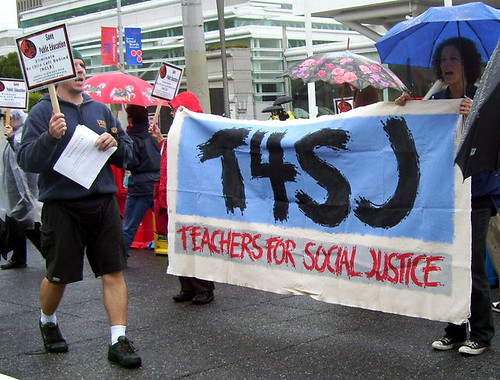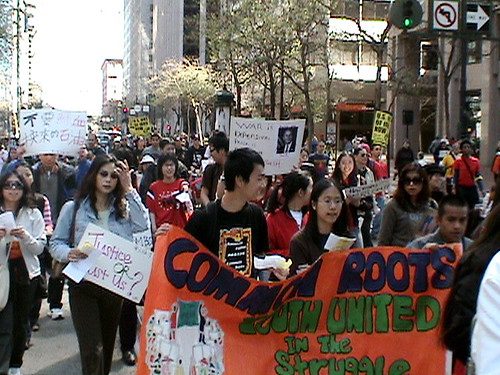 A version of this will appear in the August Newsletter of United Educators of San Francisco. http://www.uesf.org
A version of this will appear in the August Newsletter of United Educators of San Francisco. http://www.uesf.orgOn July 28th a 5:4 majority of the U.S. Supreme Court furthered chipped away at the landmark 1954 Brown v Board of Education case by striking down the school desegregation plans in Seattle, Washington, and Louisville, Kentucky. Both plans had used race/ethnicity in a limited manner for student assignment and were initiated by the local school boards to combat de facto segregation.
San Francisco teacher, parent and civil rights organizations are now debating the impact of the decision on our schools. Our Board, new Superintendent Carlos Garcia and legal staff are closely analyzing the decision and its implications for our future desegregation efforts.
In the complex split decision, the Court’s most conservative four justices - Roberts, Scalia, Alito and Thomas - argued that race cannot be used in student assignment plans or even as a factor in developing policy. Chief Justice Roberts wrote, “The way to stop discrimination on the basis of race is to stop discriminating on the basis of race."

While the new swing vote on the court Justice Anthony Kennedy wrote a concurring opinion supporting the other four conservatives in striking down the Jefferson County and Seattle plans, he importantly joined the four liberal justices in recognizing educational diversity and overcoming our history of segregation to be “compelling governmental interests” – among our country’s highest priorities – that communities can pursue through careful race-conscious efforts.
Kennedy’s opinion further defined new limits on just how race may be used in school districts with defacto segregation like ours. “This Nation has a moral and ethical obligation to fulfill its historic commitment to creating an integrated society that ensures equal opportunity to all its children.”
The ruling seems to allow the following to achieve a more integrated educational environment for districts: recruitment of school teachers and staff of diverse backgrounds; collection of data on student performance using race; and the use race as a general factor to guide decisions for new school construction and in determining attendance boundaries for a school.

Despite the striking down of the Seattle and Louisville desegregation plans, Kennedy’s 5th vote IN FAVOR OF the limited use of race in desegregation plans was at least a shred of a silver lining in an otherwise devastating decision that many civil rights advocates say has dramatically turned back the clock of civil rights and educational equity efforts many decades.
The ruling will have an impact on our desegregation and educational equity efforts in San Francisco and on hundreds of school districts throughout the country. We filed a friend of the court brief in support of both the Seattle and Jefferson County desegregation plans. Our Consent Decree monitor Stuart Biegel and many community groups have decried the rapid re-segregation and growing inequality in our district over the past 6 years and urged the San Francisco Board to reintroduce race into the student assignment system.
Our Board has been in intense discussions with our lawyers since the end or our own 1983 SFUSD Consent Decree in late 2005 – a federal court order which required SFUSD to desegregate our schools. We are now studying our existing race-neutral ‘diversity index’ and our now outdated ‘Excellence for All’ [2001] desegregation plan and are likely to decide on a new approach in the coming months after we have heard from teachers, staff, parents and other stakeholder groups.

It seems to me that the 2007 Seattle/Louisville schools decision will be remembered historically as a dark day in civil rights history. But, I agree with SF Freedom School founder and author Kathy Emery that “legal decisions in and of themselves do not create change.” The law though can contribute to fundamental social change when teachers, parents, and students use such landmarks as Brown or the Seattle decision as leverage in our organizing and fighting for broader changes like adequate funding for all schools and educational equity and equality for all of our students. Ultimately, it’s up to us – teachers, parents and communities united - to ensure equality of opportunity to all San Francisco students.
San Francisco teacher, parent and civil rights organizations are now debating the impact of the decision on our schools. Our Board, new Superintendent Carlos Garcia and legal staff are closely analyzing the decision and its implications for our future desegregation efforts.
In the complex split decision, the Court’s most conservative four justices - Roberts, Scalia, Alito and Thomas - argued that race cannot be used in student assignment plans or even as a factor in developing policy. Chief Justice Roberts wrote, “The way to stop discrimination on the basis of race is to stop discriminating on the basis of race."

While the new swing vote on the court Justice Anthony Kennedy wrote a concurring opinion supporting the other four conservatives in striking down the Jefferson County and Seattle plans, he importantly joined the four liberal justices in recognizing educational diversity and overcoming our history of segregation to be “compelling governmental interests” – among our country’s highest priorities – that communities can pursue through careful race-conscious efforts.
Kennedy’s opinion further defined new limits on just how race may be used in school districts with defacto segregation like ours. “This Nation has a moral and ethical obligation to fulfill its historic commitment to creating an integrated society that ensures equal opportunity to all its children.”
The ruling seems to allow the following to achieve a more integrated educational environment for districts: recruitment of school teachers and staff of diverse backgrounds; collection of data on student performance using race; and the use race as a general factor to guide decisions for new school construction and in determining attendance boundaries for a school.

Despite the striking down of the Seattle and Louisville desegregation plans, Kennedy’s 5th vote IN FAVOR OF the limited use of race in desegregation plans was at least a shred of a silver lining in an otherwise devastating decision that many civil rights advocates say has dramatically turned back the clock of civil rights and educational equity efforts many decades.
The ruling will have an impact on our desegregation and educational equity efforts in San Francisco and on hundreds of school districts throughout the country. We filed a friend of the court brief in support of both the Seattle and Jefferson County desegregation plans. Our Consent Decree monitor Stuart Biegel and many community groups have decried the rapid re-segregation and growing inequality in our district over the past 6 years and urged the San Francisco Board to reintroduce race into the student assignment system.
Our Board has been in intense discussions with our lawyers since the end or our own 1983 SFUSD Consent Decree in late 2005 – a federal court order which required SFUSD to desegregate our schools. We are now studying our existing race-neutral ‘diversity index’ and our now outdated ‘Excellence for All’ [2001] desegregation plan and are likely to decide on a new approach in the coming months after we have heard from teachers, staff, parents and other stakeholder groups.

It seems to me that the 2007 Seattle/Louisville schools decision will be remembered historically as a dark day in civil rights history. But, I agree with SF Freedom School founder and author Kathy Emery that “legal decisions in and of themselves do not create change.” The law though can contribute to fundamental social change when teachers, parents, and students use such landmarks as Brown or the Seattle decision as leverage in our organizing and fighting for broader changes like adequate funding for all schools and educational equity and equality for all of our students. Ultimately, it’s up to us – teachers, parents and communities united - to ensure equality of opportunity to all San Francisco students.

1 comment:
I fear that we've only seen the beginning of what the "Jim Crow Court" has in store for us.
In a few years, we may have "underground schoolhouses" in the model of the "Underground Railroad."
Post a Comment